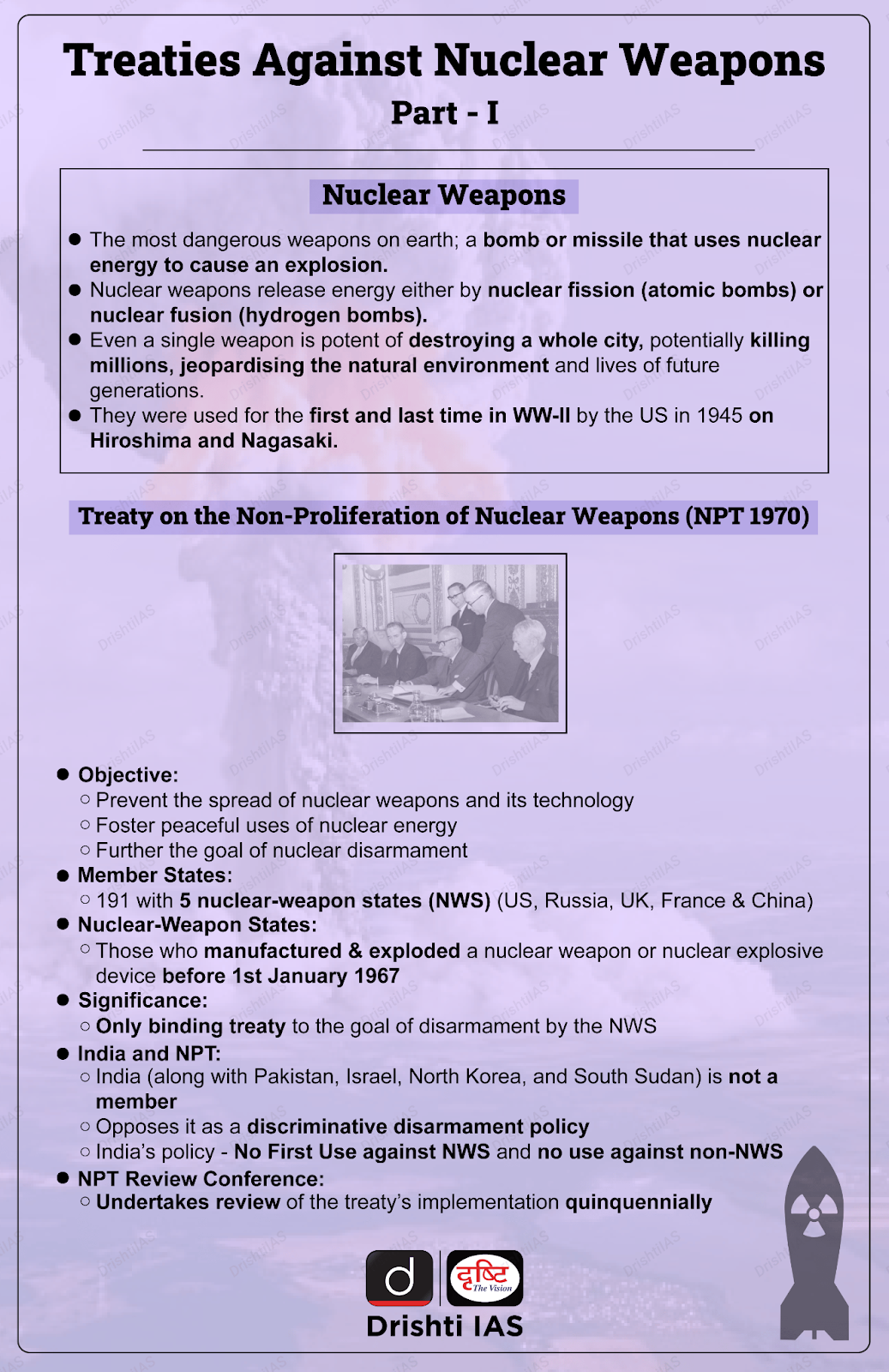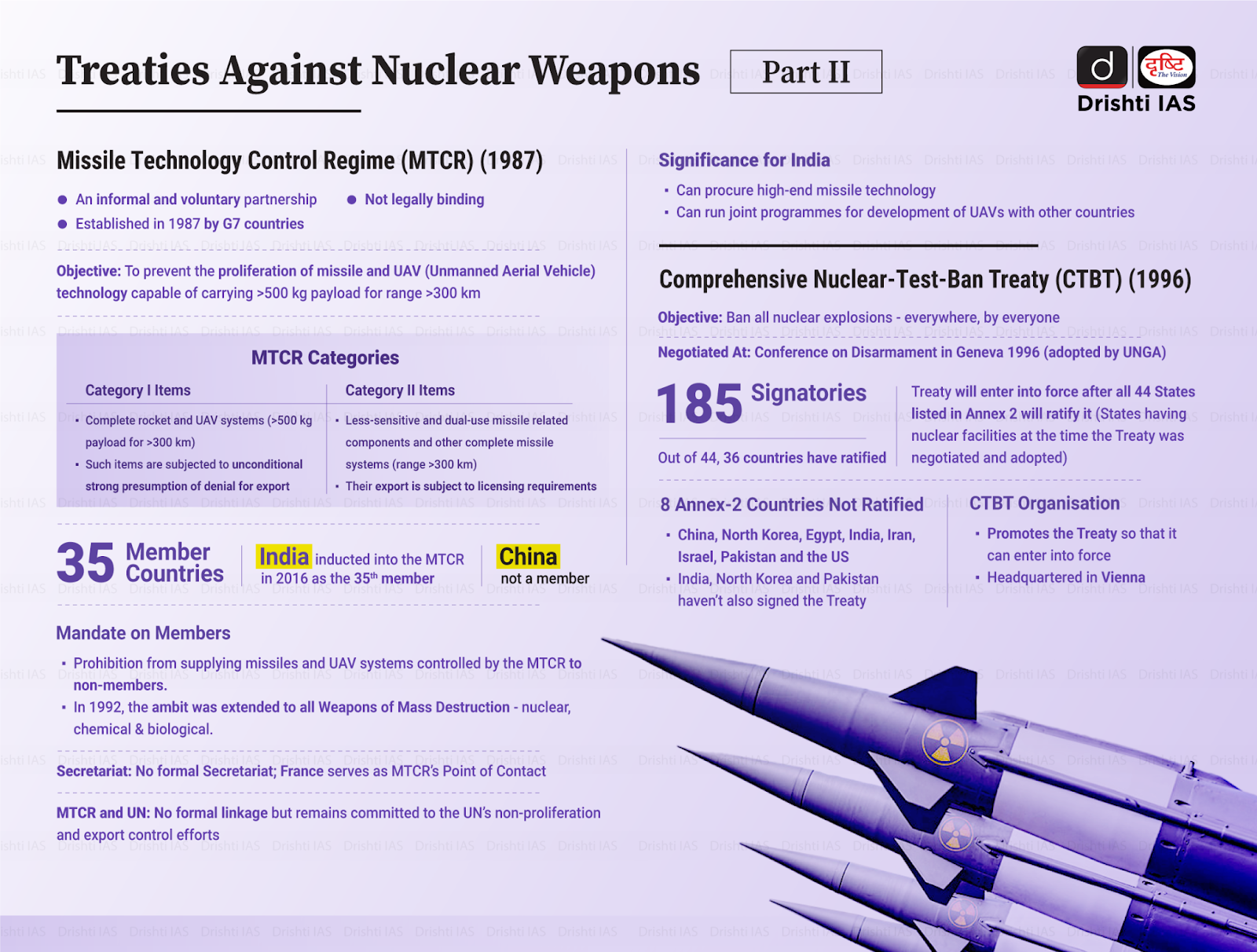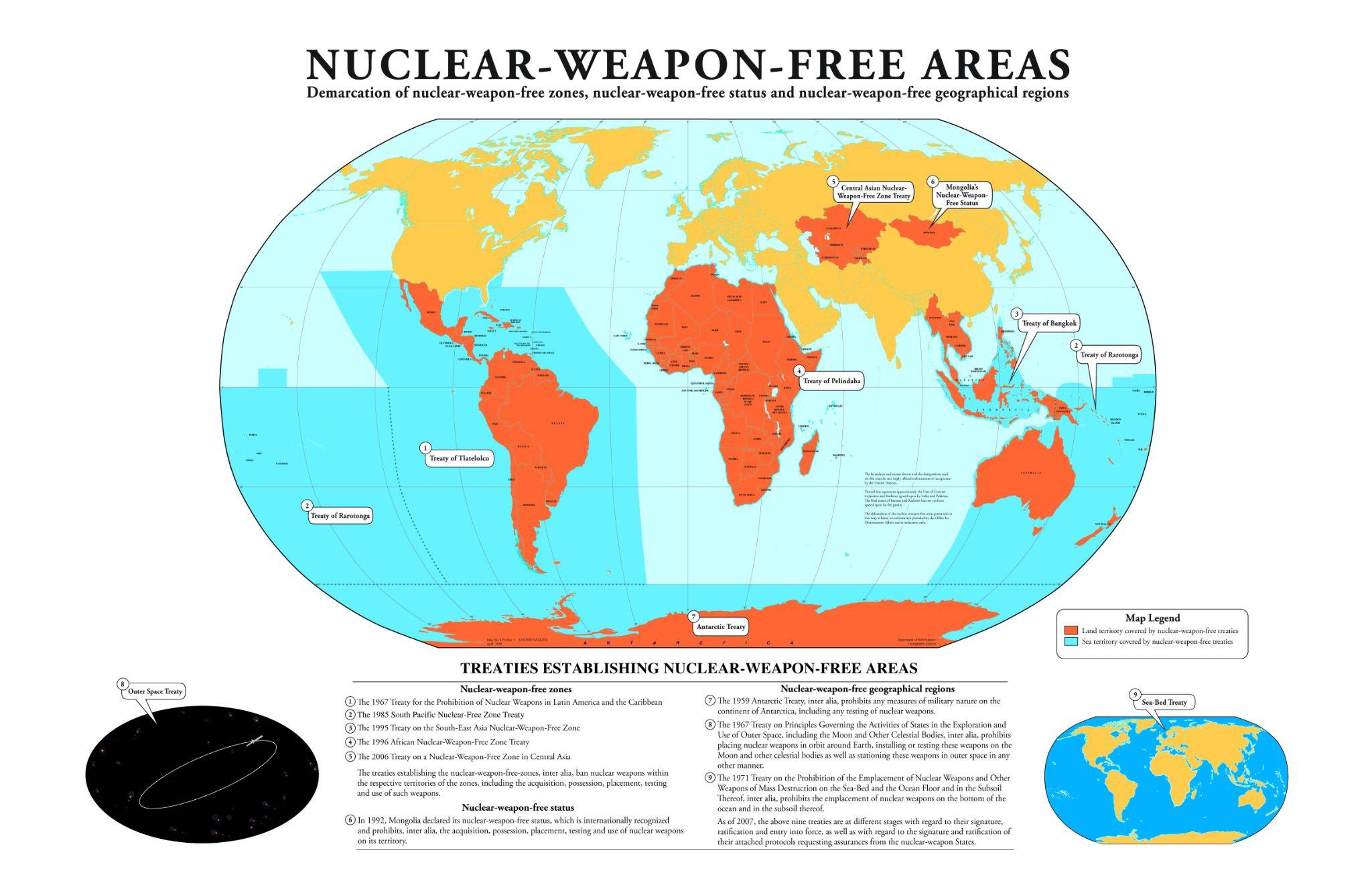Nuclear Disarmament | 24 Oct 2024
For Prelims: Nobel Peace Prize 2024, Non-Proliferation of Nuclear Weapons (NPT), Comprehensive Nuclear-Test-Ban Treaty (CTBT), International Day for the Total Elimination of Nuclear Weapons, Treaty on the Prohibition of Nuclear Weapons (TPNW)
For Mains: Nuclear Disarmament: Need, Frameworks, Challenges & Way Forward.
Why in News?
The Nobel Peace Prize 2024 was awarded to Nihon Hidankyo, an organisation representing Japanese atomic bomb survivors, in recognition of its dedicated efforts to achieve a nuclear-free world.
- This award emphasises the critical importance of advocacy for nuclear disarmament, which is deeply rooted in the catastrophic impacts of nuclear weapons experienced during the bombings of Hiroshima and Nagasaki.
Modern Threat of Nuclear Weapons
- The Hiroshima bomb had a yield of 15 kilotons (Kt), while modern weapons, such as the Tsar Bomba tested by Russia in 1961, can reach 50 megatonnes (Mt), making them over 3,800 times more powerful.
- Modern nuclear arsenals include not only large-scale strategic warheads but also tactical weapons designed for battlefield use, increasing the risk of nuclear conflict.
What is Nuclear Disarmament?
- About:
- Nuclear disarmament refers to the process of reducing or eliminating nuclear weapons to promote global security and prevent the potential catastrophic consequences of nuclear warfare.
- It encompasses several efforts aimed at controlling and ultimately abolishing nuclear arsenals, with the end goal of achieving a nuclear-free world.
- Nuclear disarmament refers to the process of reducing or eliminating nuclear weapons to promote global security and prevent the potential catastrophic consequences of nuclear warfare.
- Need:
- Humanitarian Impact: The immediate consequences of a nuclear explosion include widespread loss of life, mass destruction, severe burns, and radiation sickness.
- In addition, long-term effects such as cancer and genetic damage can affect survivors and their descendants for generations.
- Environmental Consequences: A nuclear detonation can cause large-scale environmental damage, including "nuclear winter," where smoke from explosions blocks sunlight, leading to drastic global cooling, agricultural collapse, and disruptions to ecosystems.
- Ethical and Moral Considerations: The sheer destructiveness of nuclear weapons raises ethical questions about their use.
- The indiscriminate nature of their impact goes against the principles of just war theory and humanitarian law.
- Economic Costs: Maintaining and upgrading nuclear arsenals require significant financial resources that could be used for development and addressing other pressing issues like poverty and climate change.
- Humanitarian Impact: The immediate consequences of a nuclear explosion include widespread loss of life, mass destruction, severe burns, and radiation sickness.
What are the Historical Efforts of Nuclear Disarmament Efforts?
- Treaty on the Non-Proliferation of Nuclear Weapons (NPT): The NPT entered into force in 1970 to prevent the spread of nuclear weapons and promote disarmament.
- However, it has faced criticism for being discriminatory, creating a divide between nuclear-armed and non-nuclear states.
- Comprehensive Nuclear-Test-Ban Treaty (CTBT): Though not yet fully in force, the CTBT bans all nuclear explosions, aiming to curb the development of new weapons.
- Treaty on the Prohibition of Nuclear Weapons (TPNW): TPNW includes a comprehensive set of prohibitions on participating in any nuclear weapon activities.
- These include undertakings not to develop, test, produce, acquire, possess, stockpile, use or threaten to use nuclear weapons.
What are the Different Frameworks for Nuclear Proliferation and Nuclear Disarmament?
- Global:
- International Atomic Energy Agency (IAEA): The IAEA plays a crucial role in monitoring compliance with nuclear agreements and ensuring that nuclear technology is used for peaceful purposes.
- Regional Nuclear-Weapon-Free Zones (NWFZs): These zones, where countries commit to prohibiting nuclear weapons, represent significant progress toward disarmament. Expanding NWFZs could help build momentum for a global ban.
- The first NWFZ was established in Latin America (Treaty of Tlatelolco).
- India’s Stance:
- No First Use (NFU) Policy: India has pledged not to use nuclear weapons first but reserves the right to retaliate if attacked.
- NFU policy aims to reduce the risk of a nuclear conflict while maintaining deterrence.
- Refusal to Join the NPT as a Non-Nuclear Weapon State: India has not signed the NPT, arguing that it is discriminatory because it allowed the five UNSC Permanent members (P5) to retain their nuclear arsenals while requiring other states to give up their nuclear weapons.
- Promotion of Peaceful Nuclear Energy: India supports the peaceful use of nuclear technology for energy and scientific development under international safeguards.
- Other Related Initiatives: Wassenaar Arrangement & the Australia Group
- Though these initiatives are not directly focused on nuclear disarmament, they do play supportive roles in preventing nuclear proliferation and enhancing global security.
- No First Use (NFU) Policy: India has pledged not to use nuclear weapons first but reserves the right to retaliate if attacked.
Note:
- International Day Against Nuclear Tests: The objective of observing this day, celebrated on 29th August, is to educate the public about the need to ban nuclear tests and prevent their harmful effects on people's lives and health.
- International Day for Disarmament and Non-Proliferation Awareness: Observed on 5th March and focuses on disarmament to maintain international peace and security, protect civilians, and promote sustainable development.
- International Day for the Total Elimination of Nuclear Weapons: The International Day for the Total Elimination of Nuclear Weapons is celebrated on 26th September every year to raise awareness about the threat of nuclear weapons and to promote their elimination.
What are the Challenges Related to Nuclear Disarmament?
- Global Scenario:
- Geopolitical Rivalries: Nuclear weapons are viewed by some nations as a deterrent against aggression, leading to an arms race. For instance, the nuclear arms race among nuclear-armed states like the US, Russia, and Pakistan complicates efforts toward disarmament.
- Some countries, such as the USA, lack an NFU policy, which raises concerns for nations like China and Russia, prompting them to expand and modernise their nuclear arsenals in response to perceived potential threats.
- Verification and Compliance Issues: Ensuring that countries follow disarmament treaties is difficult because nuclear weapons programs are generally unknown, making it hard to verify whether weapons have been dismantled properly.
- Technological Developments: New technologies, such as hypersonic missiles, anti-missile defence systems, and cyber capabilities, add layers of complexity to the nuclear arms race, making disarmament negotiations difficult.
- Geopolitical Rivalries: Nuclear weapons are viewed by some nations as a deterrent against aggression, leading to an arms race. For instance, the nuclear arms race among nuclear-armed states like the US, Russia, and Pakistan complicates efforts toward disarmament.
- India’s Scenario:
- China-Pakistan Nexus: China's rapid nuclear modernisation and its military partnership with Pakistan pose a dual strategic challenge for India.
- These developments, coupled with ongoing border tensions (at both fronts), compel India to bolster its nuclear capabilities to ensure a credible deterrence.
- India’s Dual Approach: India faces the challenge of balancing its nuclear deterrence while advocating for global disarmament. The country is modernising its arsenal, including developing Submarine-Launched Ballistic Missiles (SLBMs) like the K-4.
- India promotes universal nuclear disarmament and a time-bound framework at international forums, but this dual approach creates diplomatic tensions as it seeks greater global integration while remaining outside the NPT.
- Absence of Formal Arms Control Agreements: India does not have formal arms control agreements with its nuclear neighbours, unlike the bilateral arms control treaties that existed between the US and Russia (USSR) during the Cold War.
- The lack of such agreements complicates efforts to build trust and manage nuclear risks in the region effectively.
- China-Pakistan Nexus: China's rapid nuclear modernisation and its military partnership with Pakistan pose a dual strategic challenge for India.
What can be the Way Forward?
- Investing in Peaceful Nuclear Technologies: Promote the advancement of peaceful nuclear technology for energy generation, showcasing that nuclear capabilities can serve beneficial purposes instead of being limited to military uses.
- Encourage international cooperation in nuclear research for non-military uses, which can also build trust among nations.
- Enhancing Verification and Compliance Mechanisms: Invest in technologies and methodologies that enhance the monitoring and verification of nuclear disarmament agreements. Collaboration with organisations like the IAEA can improve compliance.
- Create independent bodies that can verify the status of nuclear arsenals and ensure adherence to disarmament commitments.
- Fostering Dialogue and Diplomacy: Initiate regular dialogues among nuclear and non-nuclear countries to address concerns regarding nuclear weapons and disarmament. Forums like the UN and regional organisations can facilitate such discussions.
- Develop initiatives that promote transparency, such as sharing information on nuclear arsenals and military doctrines. This can help reduce mistrust and prevent escalation during crises.
- Promoting Nuclear-Weapon-Free Zones (NWFZs): Expanding regional Nuclear-Weapon-Free Zones can serve as a significant step toward global disarmament.
- India can take the lead in advocating for the establishment of such zones in South Asia, which would help reduce the nuclear threat while promoting peaceful cooperation among nations.
Conclusion
While addressing the challenges posed by nuclear weapons is critical for global security, it is equally important to focus on the threats posed by chemical and biological weapons. These weapons are often more lethal and, alarmingly, more accessible than nuclear arms. By promoting international cooperation and robust regulatory frameworks, a safer, more secure world can be achieved, where the risks of all forms of warfare are significantly reduced.
|
Drishti Mains Question Examine India's position on nuclear disarmament. What challenges does the world face in its goal of global nuclear disarmament? |
UPSC Civil Services Examination, Previous Year Questions (PYQs)
Prelims
Q. In India, why are some nuclear reactors kept under “IAEA safeguards” while others are not? (2020)
(a) Some use uranium and others use thorium
(b) Some use imported uranium and others use domestic supplies
(c) Some are operated by foreign enterprises and others are operated by domestic enterprises
(d) Some are State-owned and others are privately owned
Ans: (b)
Mains
Q. With growing energy needs should India keep on expanding its nuclear energy programme? Discuss the facts and fears associated with nuclear energy. (2018)



